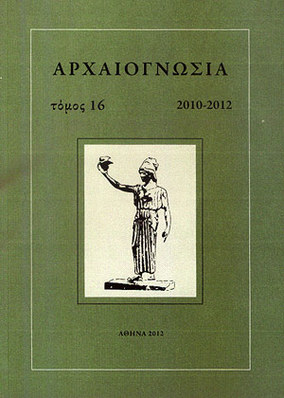Τα πήλινα αγάλματα από την Αγία Ειρήνη της Κέας
Part of : Αρχαιογνωσία ; Vol.3, No.1-2, 1982, pages 81-92
Issue:
Pages:
81-92
Parallel Title:
The terracotta statues of Ayia Irini, Kea
Section Title:
Μελέτες-Articles
Author:
Abstract:
The terracotta statues found in the Bronze Age temple at Ayia Irini, Kea, have added to our knowledge of religious activity in the Bronze Age Aegean. They have also presented us with a number of problems, archaeological and technical. A chronological terminus ante quern was provided by the destruction of the temple (by earthquake? by subsidence?) at the time ofLM IB/LHIIpottery (Ayia Irini Period VII). The statues were buried in this destruction. But subsequent repair and delving in the building scattered many statue fragments throughout the building in its lates phases. Most of these fragments were in dumped fill or used to fill interstices in the walls. At least one fragment, however, had a more notable history: the head of a statue that lay in Room 1 in destruction debris of Period VII, was found at a higher level in a Geometric re-use of this room. It had been carefully placed in a ring-stand on the floor of the shrine. The evidence indicates that to the users of the Geometric shrine the head represented Dionysos. Given the notable continuity in the temple, the question arises as to a possible relation between Dionysos and an earlier deity. The name “Dionysos” was known on the mainland in the Bronze Age (Pylos tablets Xa OóandXa 1419), but there is no written evidence for his existence in the islands a t that time. Whether or not the deity in the temple at Ayia Irini was named Dionysos in Late Mycenaean times or earlier, continuity in the temple is likely to lie in a similarity of function. The statues may be viewed as votaries.The statues were smashed in the Period VII fall of the building. It is notable that fragments of different statues, even though found together, were not necessarily in the same condition. Some were friable, some even crumbling; some were hard with sharp, clean breaks. The determining factor was clearly not the condition of the soil; the initial firing was of greatest significance. This has been demonstrated by Y. Maniatis and A. Katsanos in tests (SEM, Infrared Spectroscopy, and X-Ray Fluorescence Spectrometry) showing that fragments observed by us to be relatively soft were those with incomplete dehydroxylation, no vitrification, and a firing temperature somewhere below 65CP Celsius. Pieces with a higher firing (as much as 80(F) showed complete dehydroxylation and signs of initial vitrification. The fabric is hard.It is of great interest that these tests tended to confirm the grouping of the statues made on archaeological grounds. Moreover, the combination of SEM and Infrared Spectroscopy proved to be of significance for technological studies.The conservation of the statues presented other problems. Tests made by the conservators S. Bouzaki and A. Voutsina showed that the most satisfactory chemical product for stabilizing the clay of the statues was an acrylic polymer, Paraloid B-72 (or Acryloid, a Synthetic resin). This enabled us to checkthe crumbling and to preserve the few precious traces of color (red, white, yellow).
Subject:
Subject (LC):
Keywords:
αρχαία κεραμική , εποχή του Χαλκού , Κέα
Notes:
Περιέχει κατόψεις




